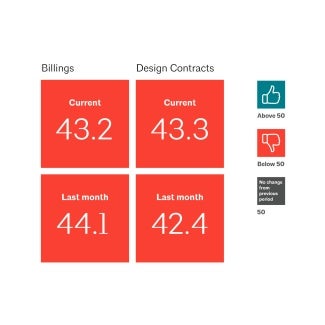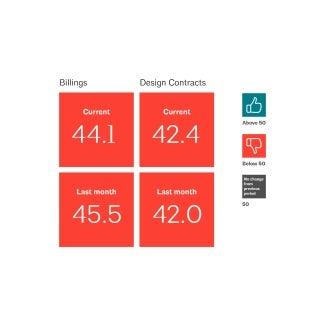January 2025 AIA Consensus Construction Forecast
After increasing in 2023 and 2024, construction spending for nonresidential buildings is projected to slow dramatically in 2025 and 2026.

Softness in construction spending predicted for 2025 & 2026
After increasing by almost 20% in 2023 and another 6% last year, construction spending for nonresidential buildings—commercial, industrial, and institutional facilities—is projected to slow dramatically this year and next. Panelists participating in The American Institute of Architects’ Consensus Construction Forecast are expecting gains of only 2.2% this year and 2.6% in 2026. Of these sectors, spending on institutional facilities is projected to see the strongest gains of 6.0% this year and 3.4% next year. Commercial construction spending is expected to increase by only 1.7% this year before climbing to 4.2% in 2026 while spending on the industrial sector should grow 2.6% this year before contracting by an almost equal amount of 2.5% next year.
The modest outlook for construction spending is partly based on a few expected headwinds to building activity, including potential tariffs on imports from selected countries, as well as the enforcement of stricter immigration policy. The threat of increased tariffs is a major source of concern regarding reigniting inflation. The threatened 25% tariffs on goods imported from Canada and Mexico and an additional 10% tariffs on goods imported from China would be inflationary to the overall economy since they are our three largest trading partners. Also, these tariffs could limit the availability of several materials and products used in construction. Among other products, the industry imports lumber and construction equipment from Canada, cement and gypsum from Mexico, and furniture, plastics, and electronics from China.
However, perhaps the biggest policy concern for the construction industry is how emerging immigration policy might impact the construction labor force. There are approximately 12 million construction workers nationally, of which about three million are foreign-born. It is estimated that half of these immigrants are undocumented, so it is likely that about one in eight construction workers nationally is undocumented. The concern is not only the potential deportation of undocumented workers but also the chilling effect on potential new immigrants who might otherwise fill construction positions in the coming years.
View interactive data from the Consensus Construction Forecast
Construction spending in the midst of a slowdown
A key question is the extent to which these potential headwinds will slow the momentum in what has been an exceedingly strong construction sector. While the performance of the industry over the past three years has been extremely impressive, it also has been unusually unbalanced. Three niche sectors in the industry—manufacturing, warehouses, and data centers—accounted for a third of all construction spending in the commercial, industrial, and institutional sectors in 2022, and that share rose to almost 40% both in 2023 and 2024. Not only are these sectors a large share of overall activity, but they are also an even larger share of spending growth in these sectors, in excess of 60% in recent years. Spending on manufacturing facilities, in particular, has seen a meteoric rise, accounting for well over a quarter of all building spending last year. In fact, ignoring the manufacturing sector, spending on nonresidential buildings increased a more modest 12% in 2022, 11% in 2023, and less than 2% last year.
Much of the increase in manufacturing has been attributed to reshoring activity. International supply chains were overwhelmed during the pandemic, encouraging U.S. producers to increase their domestic production. While this no doubt was a factor in boosting domestic manufacturing construction activity, it’s an incomplete explanation. Reshoring as a motivation for increased domestic manufacturing construction would suggest that most sectors of the economy would be involved in increasing their domestic capacity. What we see instead is that a few sectors have dominated manufacturing construction. In 2023, of the almost $200 billion in manufacturing construction spending, fully a third of it was for computer and electronics production, while an additional quarter was for the production of chemicals and pharmaceuticals, but mostly for the production of plastics. The surge in plastics production largely stems from increased domestic production of oil and gas, key inputs to plastics production.
Other than the surges in construction for manufacturing, warehouse, and data center facilities, most other sectors have seen much more modest levels of activity in recent years. Last year, construction spending declined for the retail and other commercial sector, as well as for lodging. Spending on offices saw a very modest increase only because the U.S. Census Bureau classifies data centers in the office category. The major institutional sectors fared a bit better, with spending on health care and education both increasing in the 5% to 10% range.
Construction starts, where the entire projected value of a project is assigned to the month when construction begins and is, therefore, a leading indicator of construction spending, pointing to a continued slowdown in construction spending over the coming 12 to 18 months. Total nonresidential building starts declined in 2024, according to ConstructConnect, a firm tracking construction project leads. Commercial sector starts were up at a low single-digit pace percentage-wise over 2023 levels, while institutional starts were up at a high single-digit pace. However, the big change was that starts for manufacturing facilities fell precipitously.
Forecasters predict very modest growth this year & next
The AIA Consensus Construction Forecast panel projects only very modest gains in construction spending this year and next. These projected gains of just over 2% in 2025 and under 3% in 20226 likely won’t even offset increases in material and labor costs, so the expectation is that the volume of construction is not expected to increase over the coming two years.
Within the commercial sector, spending on offices is expected to increase modestly this year and next. Spending on retail and other commercial facilities will see no gains this year before a modest uptick in 2026. Hotels are expected to see mid-single-digit growth this year and high single-digit growth next year.
The projected increase in spending on offices might seem surprising given the high levels of remote work nationally, which has produced high vacancies, growing pressure on rents, and overall weakness in that market. However, all the projected increase is coming from data centers, which the Census Bureau includes in the office category. Spending on data centers is projected to continue to see very strong growth, so spending in the core office category is expected to decline both this year and next.
The growth in e-commerce has hurt retail and other commercial facilities. The Census Bureau includes warehouses in this category, which has driven overall category growth in recent years. However, warehouse construction has become overbuilt in many areas of the country in recent years, and therefore, construction spending in this sector has slowed.
Institutional building tends to be less cyclical than commercial or industrial activity and is, therefore, less prone to a boom/bust pattern. The major institutional sectors—health care and education—are both poised for healthy but unspectacular gains this year and next. Health care construction has benefited from an aging population. Consolidation among health care providers has changed the construction focus away from large institutional campuses and toward neighborhood health centers.
Education is the largest institutional category, accounting for well over a third of the spending on institutional facilities. In addition to some upgrading of facilities that was deferred during the pandemic, demographics are the main driver of educational construction needs. As such, moving forward, construction spending for education facilities is likely to be under pressure. The Census Bureau projects our overall population to increase by 2.1% in total over the next five years. However, the preschool population is projected to increase by only 0.7%. Meanwhile, the elementary school population is projected to decline by 4%, high schoolers by just over 3%, and college-aged students by almost 2%. Those trends are expected to limit the need for new educational facilities.
Architects also project limited improvement
From a business perspective, most U.S. architecture firms faced a challenging year in 2024. Continuing the weakness that emerged mid-year 2023, architecture firms reported the softest period of billings since the onset of the pandemic in early 2020. Conditions began to look a bit more positive beginning in the fourth quarter of last year as commercial property values stabilized, interest rates began to edge down, and architecture firms began to report a resurgence in interest for new design projects. However, this optimism is not uniform; many firms still feel that additional corrections in the economy are needed before their workloads will rebound. When surveyed this past October about revenue forecasts for 2025, just over four in ten firms were projecting gains of 5% or more, a quarter were projecting losses of that magnitude, while a third felt revenue would be essentially flat. On average, design billings are projected to increase only very modestly this year. Larger firms, firms specializing in the institutional sector, and firms located in the South were the most optimistic about their expected 2025 performance.



